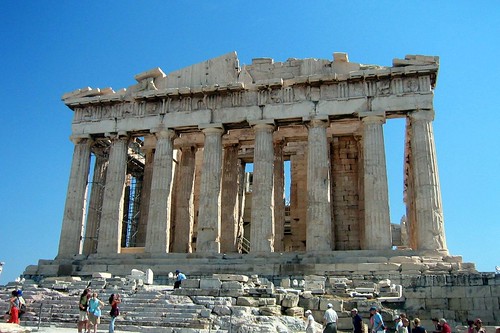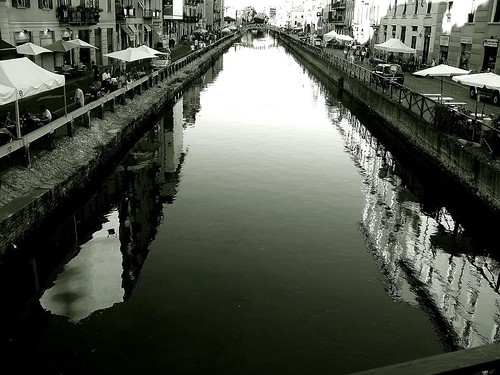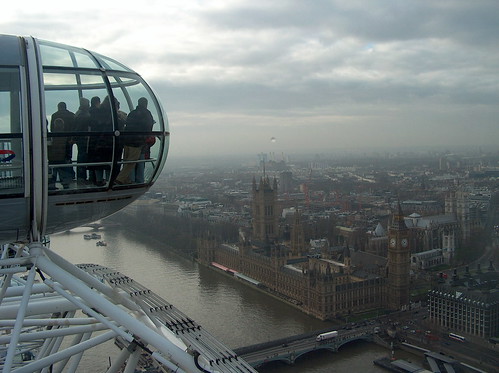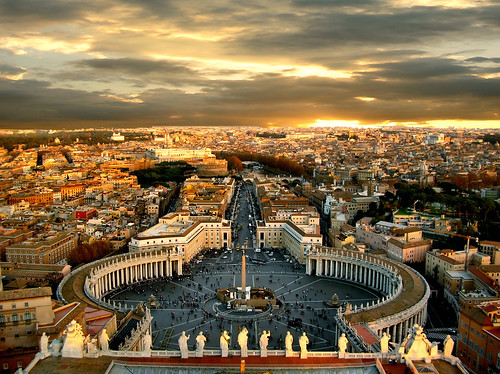I'm often asked about London's Fogs by people who live outside the British Isles. 'Peasoupers' or 'London Particulars", thick fogs described by Charles Dickens and Conan Doyle, used to occur frequently, and were due to pollution. These fhick fogs were also the origin of the colours exploited by Turner, Whistler, and Monet, in the paintings they made of London in the nineteenth Century. In December 1952 'The Great Smog of London' occurred, this was an exceptionally thick, polluted atmospheric fog that caused an estimated 4000 deaths. Following this a series of Clean Air acts were passed, these banned the use of coal in London and other cities. The result has been that fogs are now rare in London, we have only a few days of fog in a year, and it's very exceptional for it to last all day. We had some thick mist in Hyde Park at the beginning of October (it cleared soon after sunrise), however, I took some photos of the fog over the Serpentine.
Sunday, September 21, 2008
Friday, September 19, 2008
Athens - Acropolis: Parthenon (West Side)
The Parthenon (ancient Greek: Παρθενών) was a temple of Athena, built in the 5th century BC on the Acropolis of Athens. An octostyle, peripteral Doric temple with Ionic architectural features, it is the most famous surviving building of ancient Greece, and has been praised as the finest achievement of Greek architecture and one of the world's greatest cultural monuments.
The Parthenon was built at the initiative of Pericles under the general supervision of the sculptor Phidias, who also had charge of the sculptural decoration. The architects were Iktinos and Kallikrates. Construction began in 447 BC, and the building was substantially completed by 438 BC, when the chryselephantine gold and ivory statue of Athena Parthenos, from which the name is derived, was sculpted by Pheidias and dedicated and the decoration of the Doric metopes on the frieze above the exterior colonnade, and of the Ionic frieze around the upper portion of the walls of the cella were completed. Modest construction continued until the beginning of the Peloponnesian War in 432 BC. Some of the financial accounts for the Parthenon survive and show that the largest single expense was transporting the stone from Mount Pentelicus, about 16 kilometers from Athens, to the Acropolis. The funds were partly drawn from the treasury of the Delian League, which was moved from the Panhellenic sanctuary at Delos to the Acropolis in 454 BC.
In the 6th century AD the Parthenon was converted into a Christian church dedicated to the Virgin; after the Turkish conquest, it was converted into a mosque. In 1687 AD, a Turkish ammunition dump inside the building was ignited by a Venetian cannonball; the resulting explosion severely damaged the Parthenon and its sculptures. In the 19th century AD, Lord Elgin removed some of the surviving sculptures and took them to England. These sculptures, now known as the Elgin Marbles or Parthenon Marbles, are on display in the British Museum. An ongoing dispute concerns whether the Elgin Marbles should be returned to Greece.
Measured at the top step, the dimensions of the base of the Parthenon are 69.5 meters by 30.9 meters (228.0 x 101.4 ft). The cella was 29.8 meters long by 19.2 meters wide (97.8 x 63.0 ft), with internal Doric colonnades in two tiers, structurally necessary to support the roof. On the exterior, the Doric columns measure 1.9 meters (6.2 ft) in diameter and are 10.4 meters (34.1 ft) high. The corner columns are slightly larger in diameter. The stylobate, the platform on which the columns stand, has an upward curvature towards its center of 60 millimeters (2.36 in) on the east and west ends, and of 110 millimeters (4.33 in) on the sides. Entasis refers to the slight swelling of the columns as they rise, to counter the optical effect of looking up at the temple. The effect of these subtle curves is to make the temple appear more symmetrical than it actually is. Some of the dimensions form the golden rectangle expressing the golden ratio, praised by Pythagoras in the previous century. The roof was covered with large overlapping marble tiles known as imbrices and tegulae.
The ninety-two metopes were carved in high relief, a practice employed until then only in treasuries. Their design is attributed to the sculptor Kalamis. The metopes of the east side of the Parthenon, above the main entrance, depict the Gigantomachy . The metopes of the west end show Amazonomachy. The metopes of the south side (with the exception of the somewhat problematic metopes 13-20, now lost) show the Thessalian Centauromachy (battle of the Lapiths aided by Theseus against the half-man, half-horse Centaurs). On the north side of the Parthenon the metopes are poorly preserved, but the subject seems to be the sack of Troy.
The most characteristic feature in the architecture and decoration of the temple is the Ionic frieze running around the exterior walls of the cella. Carved in bas-relief, it most likely depicts an idealized version of the Panathenaic procession from the Dipylon Gate in the Kerameikos to the Acropolis. In this procession held every 4 years, Athenians and foreigners were participating to honour the goddess Athena offering sacrifices and a new peplos (dress woven by selected noble Athenian girls called ergastines). The entire frieze was carved in situ and it is dated in 442-438 BC.
The richness of the Parthenon's decoration is unique for a classical Greek temple. It is, however, in agreement with the function of the temple as a Treasury. In the opisthodomus (the back room of the cella) were stored the monetary contributions of the Delian Alliance of which Athens was the leading member.
time: 6:52 AM 0 comments:
Sunday, September 14, 2008
Temple of Olympian Zeus - Athens
The Temple of Olympian Zeus, also known as the Olympeion (in Greek Ναός του Ολυμπίου Διός or Naos tou Olimpiou Dios), is an ancient temple, now in ruins, in the centre of Athens. Although begun in the 6th century BC, it was not completed until the reign of the Emperor Hadrian in the 2nd century AD. In the Hellenistic and Roman periods it was the largest temple in Greece.
The temple is located about 500 m south-east of the Acropolis, and about 700 m south of the centre of modern Athens, Syntagma Square. Its foundations were laid on the site of an earlier temple by the tyrant Pisistratus in 515 BC, but the work was abandoned when Pisistratus's son, Hippias, was overthrown in 510 BC.
During the years of Greek democracy, the temple was left unfinished, apparently because the Greeks of the classical period thought it hubristic to build on such a scale. In the Politics Aristotle cited the temple as an example of how tyrannies engaged the populace in great works for the state and left them no time, energy or means to rebel.
The Temple of Olympian Zeus, Athens: the most substantial surviving part of the temple.The work was resumed in the 3rd century BC, during the period of Macedonian domination of Greece, under the patronage of the Hellenistic king Antiochus IV of Syria, who hired the Roman architect Cossutius to design the largest temple in the known world. When Antoichus died in 164 BC the work was delayed again.
In 86 BC, after Greek cities were brought under Roman rule, the general Sulla took two columns from the unfinished temple to Rome to adorn the Temple of Jupiter on the Capitoline Hill. These columns influenced the development of the Corinthian style in Rome.
In the 2nd century AD, the temple was taken up again by Hadrian, a great admirer of Greek culture, who finally brought it to completion in 129 (some sources say 131).
The temple was built of marble from Mount Pentelus, and measured 96 metres along its sides and 40 metres along its eastern and western faces. It consisted of 104 Corinthian columns, each 17 meters high, of which 48 stood in triple rows under the pediments and 56 in double rows at the sides. Only 15 of these columns remain standing today. A 16th column was blown down during a gale in 1852 and is still lying where it fell.
The Temple of Olympian Zeus, Athens: one of the columns, showing the typical Corinthian capital. In the background, the Acropolis topped by the Parthenon.Hadrian dedicated the temple to Zeus (known to the Romans as Jupiter), the king of the gods. He erected a giant gold and ivory status of Zeus in the cella, and placed an equally large one of himself next to it. Nothing remains of these or anything else from the interior of the temple. It is not known when the building was destroyed but, like many large buildings in Greece, it was probably brought down by an earthquake during the mediaeval period, and the bulk of its ruins taken away for building materials.
The temple was excavated in 1889-1896 by Francis Penrose of the British School in Athens (who also played a leading role in the restoration of the Parthenon), in 1922 by the German archaeologist Gabriel Welter and in the 1960s by Greek archaeologists led by Ioannes Travlos. The temple, along with the surrounding ruins of other ancient structures, is a historical precinct administered by Ephorate of Antiquites of the Greek Interior Ministry. It is open to visitors from Tuesday to Sunday.
time: 8:17 AM 0 comments:
Friday, September 12, 2008
Santa Maria sopra Minerva, Rome
Santa Maria sopra Minerva is a basilica church in Rome. The church, located in the Campus Martius region, is considered the only Gothic church in Rome, and is the city's principal Dominican church.
time: 1:28 PM 0 comments:
Monday, September 8, 2008
Milano - Il Duomo
Il Duomo di Milano, monumento simbolo del capoluogo lombardo, è dedicato a Santa Maria Nascente ed è situato nell'omonima piazza nel centro della città. È una tra le più celebri e complesse costruzioni gotiche del mondo.
Dove ora vi è il Duomo prima sorgevano l'antichissima cattedrale di Santa Maria Maggiore e la Basilica di Santa Tecla, la più grande tra le due.
Il Duomo fu costruito per volere dell'arcivescovo Antonio da Saluzzo e del signore di Milano Gian Galeazzo Visconti. Nel 1418 fu consacrato l'altare maggiore, da papa Martino V.
Nel 1400 a Filippino degli Organi e Giorgio degli Organi successero Marco Solari e Giovanni Solari da Carona, nel XV secolo Giovanni Antonio Amadeo costruttore del tiburio, Gian Giacomo Dolcebuono ed Pellegrino Tibaldi finché nel 1572 San Carlo Borromeo consacrò la chiesa anche se la costruzione non era ancora terminata.
Nel XV secolo si avvicendarono Martino Bassi, Francesco Maria Richino, Lelio Buzzi e Carlo Buzzi, i Quadrio. Nel XVIII secolo fu costruita la guglia maggiore sulla quale fu innalzata la Madonnina dorata.
Nel 1813 la facciata venne completata, quasi cinquecento anni dopo la posa della prima pietra, su istanza di Napoleone, che qui volle essere incoronato re d'Italia.
Per tutto il XIX secolo furono completate le guglie, tutte le decorazioni architettoniche ed installato il portone centrale in bronzo, autore Ludovico Pogliaghi: fra gli scultori che vi lavorarono nei primi anni dell'Ottocento, si può ricordare Luigi Acquisti.
Nel corso della seconda guerra mondiale la Madonnina venne coperta da stracci, onde evitare che i riflessi di luce sulla sua superficie dorata potessero venire usati come punto di riferimento per i bombardieri alleati in volo sulla città. Nel secondo dopoguerra, a seguito dei danni subiti dai bombardamenti aerei, il Duomo fu restaurato in gran parte e le restanti porte di legno furono sostituite con altre di bronzo ad opera degli scultori Arrigo Minerbi, Giannino Castiglioni e Luciano Minguzzi.
La manutenzione della cattedrale è affidata alla Veneranda fabbrica del Duomo i cui interventi sono continui tanto da far nascere il detto milanese di "Fabrica del Domm" per tutti quei lavori che non hanno mai termine.
time: 12:31 PM 1 comments:
London Calling
"What, I have often asked myself, really constitutes the charm of London, that something about London which satisfies you as only Rome does, that queer, disturbing vision of bridges, spires, towers, and crowded streets which comes to you at moments when you are far away and brings with it so much pain as pleasure?
"The answer is to be found in history. Behind everything in London is something else, and behind that, is something else still; and so on through the centuries, so that London as we see her is only the latest manifestation of other Londons, and to love her is to plunge into ancestor-worship.
"London is a place where millions of people have been living and dying for a very long time on the same plot of earth, drenching it with their blood, glorifying it with their nobility or degrading it with their villany, pulling it down and building it up, generation after generation, yet never destroying the vision of an earlier day."
time: 12:10 PM 0 comments:










